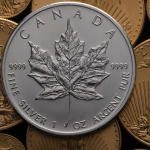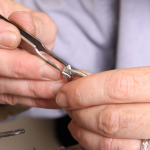Pure silver is a beautiful metal, but unfortunately, it doesn’t age well. Unlike platinum and gold, silver tarnishes over time. This occurs when silver goes through an oxidation reaction with sulfur atoms naturally found in the air – the outermost silver atoms bind to the sulfur atoms and form a patina of silver sulfide, or tarnish.
If you want your silver to shine again, you have two ways of dealing with the tarnish – you can scrub or dissolve the layer of silver sulfide, or you can undo the oxidation reaction by chemically reducing the silver sulfide back to metallic silver. The first method is faster and simpler, but removes some metallic silver along with the silver sulfide. Luckily, you don’t need a laboratory for the second method – everything you need is probably in your kitchen.
The infographic below shows you how to achieve this reduction reaction to get any silver object looking good as new. The reason it works is because the sulfur in the tarnish reacts with the aluminum foil. First, adding baking soda to the water removes the surface film of aluminum hydroxide from the foil – exposing fresh, un-oxidized aluminum. When the silver is placed in contact with the aluminum, sulfur atoms release from the silver and bind to the aluminum forming aluminum sulfide. The alkalinity from the baking soda and the heat both help facilitate this reaction. Since the aluminum sulfide isn’t stable in water, it breaks down into aluminum hydroxide and hydrogen sulfide. If you perform this reaction on heavily tarnished silver and notice a rotten egg smell – that’s the hydrogen sulfide!












